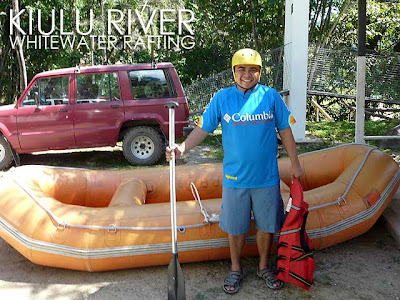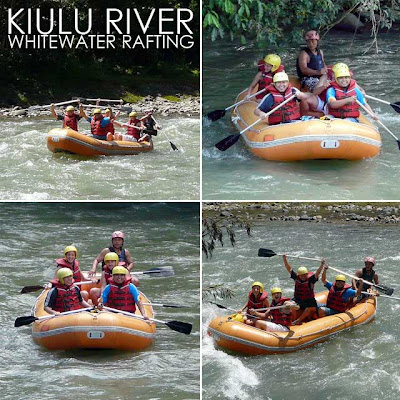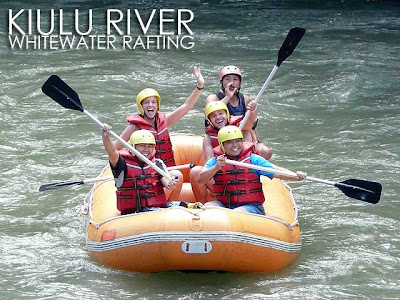 Mount Kinabalu
Mount Kinabalu is said to be the rooftop of Southeast Asia. At 4095.2 meters above sea level (MASL), it is the highest mountain in archipelagic Southeast Asia. My main reason for attempting to scale the mountain was that it is part of
Kinabalu Park, a
UNESCO World Heritage Site.

At 6:30 a.m., we were picked up at our hotel in
Kota Kinabalu for the two hour drive to Kinabalu Park. There is a brief stopover at a place called
Nabalu where you could shop for fruits and supplies as well as take photos of Mount Kinabalu from a distance. We bought some bananas for potassium as well as isotonic drinks for the trek up.
The entrance of Kinabalu Park was about 15 minutes from Nabalu. At the park headquarters, our driver made all the arrangements for our permits, fees (permit, environmental, insurance, etc.), mountain guide and porter. They are very strict at Kinabalu Park since they require climbers to have a permit if you want to hike up Mount Kinabalu.

The permit is a plastic ID card which contains your name, permit number and the date you entered. You must wear the ID at all times since rangers check at various points on the mountain. Each group is also required to have a guide who must accompany you at all times, following the last person of the group.
There are two trails that lead up to the summit, the Timpohon and Mesilau Trails. The
Timpohon Trail is the shorter and more popular route. It’s approximately 6 kilometers to Laban Rata, and an additional 2.72 kilometers to the summit which is known as Low’s Peak, for a total of 8.72 kilometers. The
Mesilau Trail is 1.6 kilometers longer and navigating it is more challenging since the trail is not as developed as Timpohon. The two trails converge after KM 4 of Timpohon.

At the Timpohon Gate (1866.4 MASL), the guide is required to give you one final briefing before you are allowed to enter the gate. He then submits a record to the ranger at the gate who will ask you to sign beside your name and check that you are wearing the correct permit. From there begins the 6-kilometer trek up Laban Rata, the accommodation facility 3272 meters up Mount Kinabalu. Take note that accommodations and meals at Laban Rata have to be prearranged and reserved way in advance.

Along the way are several shelters called
pondoks which serve as rest areas. Each
pondok has a toilet and running water. But you will have to provide your own toilet paper. These
pondoks, together with their altitude and distance from the previous one, are
Pondok Kandis (1981.7 MASL, 793 meters from Timpohon Gate),
Pondok Ubah (2081.4 MASL, 441 meters from Kandis),
Pondok Lowii (2267.4 MASL, 750 meters from Ubah),
Pondok Mempening (2515.45 MASL, 920 meters from Lowii), the
Layang-Layang Staff Quarters (2702.3 MASL, 950 meters from Mempening),
Pondok Villosa (2960.8 MASL, 934 meters from Layang-Layang) and
Pondok Paka (3080.42 MASL, 417 meters from Villosa) before you finally arrive at the
Laban Rata Resthouse (3272.2 MASL, 550 meters from Paka). Between
pondoks, there are also distance markers every 500 meters of the trail.
One thing that also surprised me was that mobile phone signals were very strong throughout the trek. And this is so that communication is easily facilitated especially during emergency situations.

It is a very scenic trek and the trail is quite developed. But it is no easy trek for any beginner and navigating it will require some preparation and a certain level of physical fitness. Hiking up to Laban Rata usually takes 4 hours. The average time to get up is about 5 hours. Longer than that is slow. And we fell into that category since me and my companion had to push our physically unfit bodies up to Laban Rata for a total of 8 hours! But to make the long story short, we made it up before it got dark and in time for dinner.

Laban Rata Resthouse is the main accommodation on Mount Kinabalu and the most convenient since the food is served there. There are other huts scattered around the area, namely
Gunting Lagadan Hut,
Panar Laban Hut and
Waras Hut. But staying in those huts will require you to walk to the main building in Laban Rata for meals. The facilities are managed by
Sutera Sanctuary Lodges. Despite being basic facilities which include dorm rooms and common showers, the dorm beds are not cheap since everything, including food and supplies, has to be brought up daily by porters. Private rooms are even more expensive and very limited. Unfortunately, there was no warm water when we got there due to problems with electricity supply. So no one in the entire lodge dared take a shower since the cold water was not good for the muscles.

Lights out is very early since everyone wakes up between 1:30 to 2 a.m for a light breakfast before attempting to scale the summit. The trail opens at 2:30 a.m. and you’ll have to be up really early because the park rangers will allow attempts up Low’s Peak only at certain times, especially for those who are not experienced climbers. Unfortunately, altitude sickness is also another thing you have to face. And unfortunately, I got hit several hundred meters up the trail. Low’s Peak unfortunately had to wait another day.


Down at Laban Rata, I took a short nap before waking up to watch the sunrise. Another breakfast buffet is served and heavier than the one at 2 a.m. which is available just in time for those returning from the summit.
Going down back to the Timpohon Gate was easier for me. And I managed to make it down in four hours, half the time I took to get up. It also gave me more time to appreciate the flora and fauna, including the nepenthes (pitcher plants) and orchids. Note that there are a thousand species of orchids documented in Kinabalu Park. And you’ll notice a good number of them in bloom along the trail.

After going through the Timpohon Gate, the ranger takes note of your permit number and logs down that you've exited. At the gate, we were picked up by our driver for the 4-kilometer drive down to the Park Headquarters where a buffet lunch was waiting for us.
At the headquarters, we received our certificates that note how far we were able to climb up. After the late lunch and some rest, we made our way back to Kota Kinabalu. Others would choose to stay in the park to rest and recuperate.
How to get to Mount Kinabalu from Kota Kinabalu
You can try arranging your climb on your own. But the convenient way is to get a tour package which already includes transfers from Kota Kinabalu and back. Here is a
list of travel agencies from the Sabah Tourism Board.
Public transportation conveniently passes by the gate of Kinabalu Park. Vans leave the Merdeka Field in Kota Kinabalu between 7 a.m. to 3 p.m. daily and the fare to Kinabalu Park is about RM17. Time of arrival varies since the vans pick-up and drop off passengers along the way. So make sure you take the first van if you are to arrive at the park HQ in the morning. Later than that means you might have to book a place to stay for the night in or close to the park HQ and trek the next day.
Preparing for a Mount Kinabalu climb
Climbing Mount Kinabalu requires a lot of preparation with logistics and physical training. Here are some things to remember when planning a trek up Mt. Kinabalu:
1. Book your accommodation way in advance
Accommodation at Laban Rata and the nearby huts is usually full. It's not a good idea to make reservations only when you arrive at the park headquarters. Beds at Laban Rata, if these are still available, are the most convenient. While you can make your bookings directly with Sutera Nature Lodges (which is usually packaged with meals), it may be more convenient to find a travel agency to do all the bookings for you since their packages include round-trip transfers from Kota Kinabalu to the park HQ and Timpohon Gate, and all the permits and fees. You simply wait and walk around the park HQ as they take care of all your papers, permits and coordination with the park management.
Permit fee for non-Malaysian is RM100 (US$32) per person. Other fees include the insurance fee RM7 (US$2.25), conservation fee RM15 (US$5), and guide fee RM85 (for 1 to 3 persons from Timpohon). Porters can also carry your luggage but it will cost RM80 (US$27) for up to 10 kilos, and RM8 (US$2.50) for every kilo thereafter.
A dorm bed accommodation at Laban Rata Resthouse (based on 2010 tariff rate) costs RM435 (US$140) while beds at Gunting Lagadan, Waras and Panar Laban cost RM385 (US$123). A room good for 2 persons at Laban Rata cost RM920 (US$294). While a room good for 6 persons is RM2835 (US$905). Rates include packed lunch on the way up, buffet dinner, early supper and breakfast at Laban Rata, and buffet lunch at Kinabalu Park Balsam Restaurant. For accommodation in Kota Kinabalu, here is a
list of accommodation from the Sabah Tourism Board. Just click on the accommodation type to get the full list.
Bilik Operasi Taman Kinabalu (Park HQ)
+60 88 889095 / +60 88 889099 / Fax No. +60 88 889068
Sutera Sanctuary Lodges
+60 88 318888 / Fax No. +60 88 308449
info@suterasactuarylodges.com.my
 2. Bring the proper equipment
2. Bring the proper equipment
Don't take your equipment for granted. At the very least, make sure you have reliable trekking shoes from reputable brands.
(1) Shoes: Before the climb, I made sure to pass by R.O.X. and they suggested I try out the
Salomon XA Pro 3D Ultra trail running shoes. The grip of the shoes was really good. And I liked the fact that the shoes are water-proof and kept my feet dry despite the rains in Mount Kinabalu. I remember wearing ordinary shoes during previous rainy climbs and had deal with soggy socks. Plus the Salomon shoes served as cushions which were very helpful on the way down. No blisters on this trek!
(2) Water-proof jacket: Also make sure you have a water-proof jacket which is handy especially when it rains or when the winds are strong. I had
The North Face Mammatus Jacket with me.
(3) Fleece jacket: You should also bring a fleece jacket with you and the Salomon Track Hoody worked wonders for me in the cold weather with its actiTHERM technology.
(4) Trekking pants: The Columbia Titanium line is a good choice. The pants I used were
Columbia Titanium. Also don't forget your
(5) Gloves,
(6) Hat or tuque and
(7) Thermal socks. It would also be wise to bring
(8) Trekking poles. I had two with me. You'll also be required to bring a
(9) Headlamp and
(10) Whistle for the pre-dawn ascent to the summit. Also bring a
(11) Socket adapter which you will need for essential charging.
3. Be physically-prepared for the climb
They say it's mostly steps going up to the summit. But it's no walk in the park. The trail is 8.72 kilometers and you will climb a total of 2228.8 meters to reach the summit. So make sure you are physically fit and train properly to be able to attempt this climb.
In emergency situations, they carry climbers down using a stretcher. But it is the park ranger who determines whether it will be charged to insurance or personal account. Only accidents get charged to insurance. If it's only muscle cramps, you can get charged at least RM400 per kilometer or approximately RM3200 (US$1000) from the summit down. So better make sure you're fit!


































